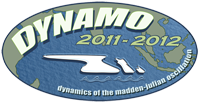

|
Matlab and CfRadial
|
Gan, Maldives
|
[The documents available here have been directly copied from the DYNAMO field web server. These are considered static documents. The source code has been updated in some cases, but is mostly frozen as it was for DYNAMO. -- RAR, 6-Mar-2012]
The documents included here are:
The routines included here are designed to work with the latest version of CfRadial format S-PolKa data. The routines are provided as examples, and may even be useful. There are no guarantees provided with any of the routines.
CfRadial are written in netCDF4 with HDF5 compression. This format will be used as the native format for S-Pol data in DYNAMO.
Within Matlab, you must use the HDF5 routines to read the CfRadial compressed files. Matlab R2011a has in-built support for HDF5, with the inclusion of some new, "high level" routines. It is assumed that you are using R2011a or better.
HDF5 is efficient, in that if you know the name of the parameter that you want, you can quickly recover that parameter from an HDF5 through use of addressing to the appropriate place in a file. In contrast, if you wish to read an entire file, HDF5 is not terrribly efficient, and the Matlab built-in routines can take as long as 20 seconds to scan an entire S-Pol volume file.
The most time-consuming part of reading S-Pol CfRadial files is in first determining the full set of attributes within a file (this step uses the high-level matlab routine h5read). If you can assume that the general nature of a file remains unchanged over some time period, you can read the attributes once, and then just recover the parameters you require for succeeding files. This would be a highly efficient approach.
CfRadial has the option of *not* using HDF5 compression. In such a case, you can just use netcdf routines to manipulate the data.
CfRadial can have a mix of variables where some may require application of a scale and bias.
CfRadial data may use "ragged beams": beams may be clipped to save storage space. Generally, clipping is constant with elevation tilt, but there is no guarantee that this will always be the case.
CfRadial uses a few parameters whose names begin with an underscore (_). Matlab will upchuck on these if you incorporate the name in a structure.
The routine "get_and_scale_hdf5_data.m" handles the scaling/no scaling, and creates beams of uniform length. The routine also modifies a parameter name if it begins with an underscore.
A separate routine is used to inspect the Attributes structure to determine which parameters are "radar space" parameters. There is no a prior way to know which parameter names represent radar space variables.
Typical directories might be (from some TBD starting directory):
./cfradial/covar/kband/sur/20110929 ./cfradial/covar/kband/rhi/20110929 ./cfradial/covar/kband/sec/20110929 ./cfradial/covar/sband/sur/20110929 ./cfradial/covar/sband/rhi/20110929 ./cfradial/covar/sband/sec/20110929 ./cfradial/moments/kband/sur/20110929 . . ./cfradial/moments/sband/sur/20110929 . . ./cfradial/partrain/sband/sur/20110929So, depending upon what kind of scans you want to review, and which radar, not to mention the "data type", you need to be aware of the directory structure.
If you wish to review *all* files for a given day (I do this when I review accuracy of antenna pointing), you need a time-sorted list of file names.
This is provided in the routine "get_sorted_file_list.m"
I have only a few routine that I consider operationally ready.
main_timeline_multi_plot inspects all of the CfRadial files for a given day, and plots a time history of every beam of data. This is useful in determining periods of missing data for any of our multiple data sets. You can determine if you have lost Ka data compared to S-band data, or you can see that the S-band transition beams have been deleted from the covar data set. This routine can pass through ~30 GB of files in less than a minute (this really shows the efficiency of HDF5).
The main_timeline_multi_plot also inspects the timestamp of dorade files to ensure that they generally match time periods of the cfradial data.
The AntPerf.m routine is a fully GUI-driven program to display antenna pointing performance information. [Note: I need to track down an error with the default starting directory name].
There is the beginning of a bscan routine, although the color tables are currently minimally managed for this routine.
There is also a complete routine that computes the volume-weighted fraction of the PID echo types within a scan volume.
The routines here are still evolving, but are likely to go into DYNAMO in nearly the current condition. If you find errors, or make improvements, please let me know.
Bob Rilling
rilling@ucar.edu